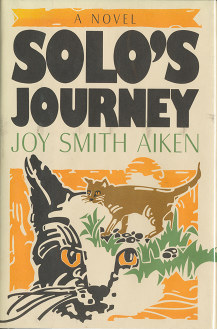December 2012
Austrian TV show 'heute leben' covers local fursuiters
Posted by GreenReaper on Sat 1 Dec 2012 - 18:40The Austrian Broadcasting Corporation's afternoon television show "heute leben" (live today) featured a five-minute segment on furries (translation) this Friday. [tip: Chaoskobra]
The term furries refers to the lifestyle of a youth culture that likes to dress as life-sized animals. They are called "fursuiter" meaning "fur wearer". Most of them sew their own elaborate costumes, and from time to time emerge to confuse the general public.
The footage focussed on fursuiters, but was very positive about the hobby:
They don't see themselves as crazy, just adults who like to have fun & try new things. It doesn't harm anyone and they believe that it makes the world a more colorful place.
Review: 'Solo's Journey', by Joy Smith Aiken
Posted by Fred on Sat 1 Dec 2012 - 21:54
The lives of the Quorum cats are filled with paradoxes: Although feral and untamed, they live within sight of the Owners’ dwellings and feed off the scraps in the Keep; although peace-loving, too often the Quorum enforcers and bards are forced to protect and defend their territory from the ravages of invading gypsy cats from outside the territory. But the plight of the Quorum becomes desperate when the Owners attempt to demolish their territory and threaten the lives of the cats themselves. It is left to Solo to lead them to safety, as he tries to persuade them to abandon their homes and traditions and learn to survive beyond the Owners’ domain. Even as their dens go up in flames, Solo helps the Quorum cats execute their escape; slipping into the welcome cover of darkness, the feline exiles now begin their tortuous quest for a new land. (blurb)
Solo’s Journey is a talking-cat fantasy, in the tradition of Tad Williams’ Tailchaser’s Song and so many others (why are there almost no talking-dog fantasies?), going back ultimately to Richard Adams’ Watership Down for its “realistic” animal species with a detailed language.
G. P. Putnam’s Sons, November 1987, 255 pages, 0-399-13321-6, $17.95. Map by Scot Aiken.
Video games: 'Girl Genius and the Rats of Mechanicsburg'
Posted by Fred on Sat 1 Dec 2012 - 22:01Phil and Kaja Foglio’s Hugo Award-winning Girl Genius Internet steampunk comic strip recently started a Kickstarter campaign to raise $7,500 to create the first Girl Genius video game for iOS and (eventually) Android. It features Krosp, Agatha Heterodyne’s anthropomorphic white cat, versus the Maus King and his army of clockwork rats.
With $18,109 already pledged and 22 days to go, the question is not whether the campaign will succeed but what new goals will be added. There is a 1’57” video on their website.
Review: 'Flight of the Star Phoenix', by Bernard Doove
Posted by Fred on Sun 2 Dec 2012 - 01:09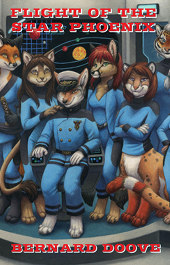 Six of Bernard Doove’s last seven books have been set in his 24th century “Chakat Universe”. So is Flight of the Star Phoenix, but with a difference. These are the adventures of the starship Phoenix, captained by a coyote morph and crewed by just about every species in Doove’s universe. Chakats are included in the mix, although this is not really a chakat story.
Six of Bernard Doove’s last seven books have been set in his 24th century “Chakat Universe”. So is Flight of the Star Phoenix, but with a difference. These are the adventures of the starship Phoenix, captained by a coyote morph and crewed by just about every species in Doove’s universe. Chakats are included in the mix, although this is not really a chakat story.
This novel is really an assembly of the thirteen Phoenix stories that have appeared on Doove’s “Chakat’s Den” website. They are called chapters, but they read more like a collection of separate short stories. Although the book has an overall theme – in 2332-2337, the interstellar freighter Phoenix must prove itself financially profitable by its fifth anniversary or go out of business – it reads more like thirteen separate adventures during those five years, with individual beginnings, plots, climaxes, and conclusions. Fans of short, episodic starship adventures will enjoy this more than the fans of long novels. And the fans of Doove’s regular chakat tales will be very satisfied with it.
CreateSpace, November 2012, trade paperback $21.95 (388 pages). Illustrated.
Anthro animation airs at Aero Theatre, Santa Monica, Dec. 7
Posted by Fred on Sun 2 Dec 2012 - 02:49For fans of Robert McKimson’s Leon Schlesinger/Warner Bros. 1940s-1950s theatrical cartoons, there will be a screening of 35 mm. prints of eleven of them on Friday, December 7, 2012 at 7:30 p.m. at the Aero Theatre, 1328 Montana Avenue, Santa Monica, CA 90403; (310) 260-1528. The eleven, which McKimson was the director of, include Hillbilly Hare, Devil May Hare, Rabbit’s Kin, Hot Cross Bunny, The Foghorn Leghorn, Bedevilled Rabbit, Bill of Hare, Tabasco Road, The High and the Flighty, Falling Hare, and Walky Talky Hawky; featuring Bugs Bunny and Foghorn Leghorn & Henery Hawk.
This event is in celebration of publication of the brand-new biography I Say, I Say….Son! A Tribute to Legendary Animators Bob, Chuck, and Tom McKimson, by Robert McKimson Jr., with a foreword by John Kricfalusi (the creator of Ren & Stimpy) and an introduction by Darrell Van Citters. McKimson Jr., Kricfalusi, and Van Citters will sign copies of the book in the lobby beginning at 6:00 p.m., and hold a discussion following the screening.
(And don’t miss my review of the book.)
Fyodor Khitruk, 1917-2012
Posted by Fred on Tue 4 Dec 2012 - 03:28Fyodor Khitruk died today. He was the leading Soviet animator from about the 1960s to until the Soviet Union ended in 1991. I met him briefly at the 1989 International Festival of Animation here in Los Angeles. He had brought the leading animators from each of the 15 Soviet republics to L.A. with him. They stood around muttering something like, "What are we doing in America?" "I don't know, but Fyodor said that we had to come."
I remember that he was an extremely imposing personality, probably the most dynamic person at the festival even though he was a dumpy old man. He was the sort of man who dominated a crowd even when he was just standing around doing nothing.
Khitruk was born just before the Russian Revolution, so he lived through the entire Soviet era. His animation tended to be the "arty" style that won awards but lost money because it was too intellectual. The Soviet government subsidized that sort of thing in the name of "we are not profit-oriented capitalists", but when the Soviet Union ended and the new Russian government was profit oriented, Khitruk could not get his films funded any more because they were not commercial. He mostly taught animation at the Moscow Academy since then.
He was not known for anthropomorphic characters, but he made very cute films of three Winnie the Pooh stories in the 1960s and 1970s that are nothing like Disney's, and are good enough to justify his obituary on Flayrah. Here is the second of them.
MiDFur names Steve Gallacci and Sofawolf Press as Furry Hall of Fame 2012 honorees
Posted by Fred on Wed 5 Dec 2012 - 06:17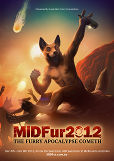 The MiDFur 2012 convention, currently going on in Melbourne, Australia, has just inducted Steve Gallacci, one of the founders of Furry fandom, and Sofawolf Press into its Furry Hall of Fame. Steve and Sofawolf co-founder Tim Susman and associate Mark Brown are present at MiDFur to accept.
The MiDFur 2012 convention, currently going on in Melbourne, Australia, has just inducted Steve Gallacci, one of the founders of Furry fandom, and Sofawolf Press into its Furry Hall of Fame. Steve and Sofawolf co-founder Tim Susman and associate Mark Brown are present at MiDFur to accept.
Prior Furry Hall of Fame inductees (who select new members annually) are 2 the Ranting Gryphon, BigBlueFox, Dr. Samuel C. Conway, CynWolfe, Bernard Doove, Jenner, Paul Kidd, Fred Patten, and Stan Sakai.
Sparrow chosen as mascot of 2013 Athletics Championships
Posted by Higgs Raccoon on Wed 5 Dec 2012 - 15:31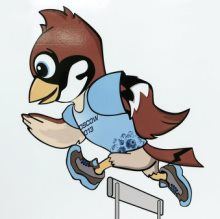 In 2013, Moscow will play host to the 2013 World Championships in Athletics. On Wednesday, organisers unveiled the event's mascot – an anthropomorphic sparrow in a blue T-shirt and running shoes.
In 2013, Moscow will play host to the 2013 World Championships in Athletics. On Wednesday, organisers unveiled the event's mascot – an anthropomorphic sparrow in a blue T-shirt and running shoes.
The sparrow was amongst more than 200 designs submitted by the public over the Internet. Mikhail Butov, the general secretary of the Russian athletics federation, explained why the sparrow was chosen:
The bird shares a lot of qualities with the athletes: It's quick, light and nimble.
Necomimi creator seeks funding for wearable waggy tail
Posted by Huskyteer on Wed 5 Dec 2012 - 16:56Shota Ishiwatari, who worked on prototypes of the necomimi brainwave-activated cat ears for Neurowear, has turned to Kickstarter to fund a new, independent project, Tailly.
Attached to a belt, Tailly responds to the wearer's heartbeat to produce a wagging motion when a raised heart rate indicates excitement, slowing to a swing as the heartbeat drops. The tail comes with a white furry cover as standard; black, brown and grey are available.
Update (29 Jan): The campaign failed, but it's been restarted on Indiegogo.
Review: 'Earthman's Burden', by Poul Anderson and Gordon R. Dickson
Posted by Fred on Thu 6 Dec 2012 - 00:09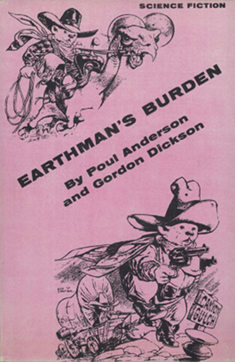 Humorous science fiction is all too rare. One of the most successful humorous series is/are the Hoka stories of Poul Anderson & Gordon R. Dickson. They began in the short-lived Other Worlds Science Stories in May 1951, moved to Universe Science Fiction after Other Worlds ceased publication, then to The Magazine of Fantasy and Science Fiction when Universe bit the dust.
Humorous science fiction is all too rare. One of the most successful humorous series is/are the Hoka stories of Poul Anderson & Gordon R. Dickson. They began in the short-lived Other Worlds Science Stories in May 1951, moved to Universe Science Fiction after Other Worlds ceased publication, then to The Magazine of Fantasy and Science Fiction when Universe bit the dust.
By 1957 there were almost enough Hoka stories to fill a book. Anderson & Dickson added one original story and a short “Interlude” after each to tie them together into a novel, and Earthman’s Burden was the result.
The 1950s were the postwar era with the Marshall Plan and the sparklingly new United Nations, when idealistic America was trying to pull the whole world up to Western levels of prosperity and democracy. The Hoka stories carried these ideals into space.
NYC, Gnome Press, July 1957, 185 pages, $3.00 [1970 reprint; 1979 reprint]. Illustrated by Edd Cartier.
Animation: 'Pups of Liberty'
Posted by Fred on Sat 8 Dec 2012 - 18:50Pups of Liberty: The Boston Tea-Bone Party, an educational animated short film by Bert and Jennifer Klein’s Picnic Pictures – available on DVD from Amazon.com for $15 (or from izzit.org); 18 minutes -- about the outbreak of the American Revolution, featuring dogs as the American colonists and cats as the British oppressors, has been referenced on the Internet since 2009; but I do not believe that it has been reported on Flayrah.
This new Cartoon Brew post reveals that it was made by moonlighting Disney animators, including many top names.
Of more anthropomorphic interest, however, is the commentary on this article, arguing whether it is “natural” to portray cats oppressing dogs. Why not dogs oppressing cats? Or cats oppressing mice? Or mice oppressing cats? Or any animals oppressing any other animals, because this is a humanocentric concept that animals do not really share?
Do any Furry fans have any comments on this? The Cartoon Brew’s website is open.
U.S. government petitioned to drop drug war, create cat girls
Posted by Rakuen Growlithe on Sun 9 Dec 2012 - 06:48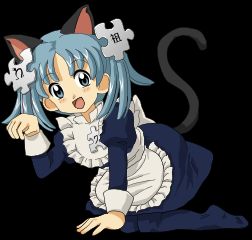 The U.S. administration created We The People to provide a place for any of its citizens to petition the White House, which has promised to provide an official response to all petitions reaching 25?000 signatures within 30 days. While some cover serious political issues, it's doubtful that they expected Matthew H's petition for domestic cat girls. [Yahoo!]
The U.S. administration created We The People to provide a place for any of its citizens to petition the White House, which has promised to provide an official response to all petitions reaching 25?000 signatures within 30 days. While some cover serious political issues, it's doubtful that they expected Matthew H's petition for domestic cat girls. [Yahoo!]
Matthew contends that the War on Drugs is pointless, and that money would be better spent by genetically engineering cat girls for home services.
While reports by the Global Commission on Drug Policy suggest the war has been a dramatic and costly waste of money, lives and society, and has harmed the fight against HIV/AIDS, it is unlikely that the U.S. will abandon it any time soon. Both Colorado and Washington have legalised non-medicinal marijuana, but its possession is still a federal offence.
